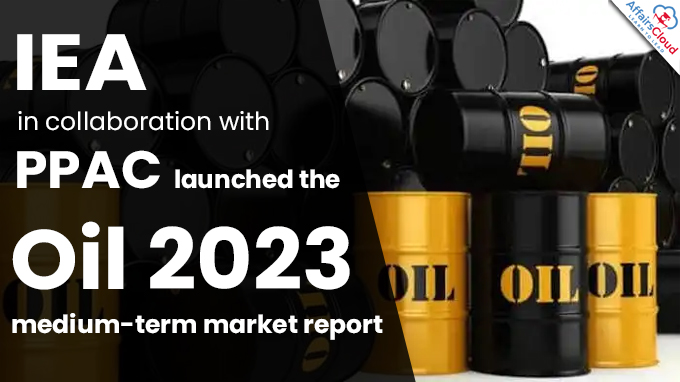
On 17th July 2023, The International Energy Agency (IEA), Paris(France)-based autonomous organization, in collaboration with Petroleum Planning and Analysis Cell (PPAC) under the administration of Ministry of Petroleum and Natural Gas (MoPNG) launched the Oil 2023 medium-term market report titled IEA Oil 2023 – Supply and demand dynamics to 2028 in Delhi for oil supply and demand.
- The Oil 2023 medium-term market report forecasts that based on current government policies and market trends, global oil demand will rise by 6% between 2022 and 2028 to reach 105.7 million barrels per day (mb/d).
- India`s demand for energy is growing faster than any other major economy and is expected to grow in all sectors due to favourable demographics supported by urbanization and industrialization.
Key People:
Pankaj Jain, Secretary, MoP&NG; Toril Bosoni, Head of Oil Industry and Markets Division, IEA.
Consumption of petroleum products in FY 2022-23:
i. The overall consumption of petroleum products in FY 2022-23 was at 223 Methylcyclopentadienyl manganese tricarbonyl (MMT).
- The growth rate was about 12% over the previous year (FY 2021-22)
ii. This growth in the petroleum products has been influenced by growth in High Speed Diesel(HSD) at 12.1%, the largest contributor with 85.9 MMT and Motor Spirit (MS)(petroleum) with 34.9 MMT consumption during 2022-23 at a growth rate of 13.4% 2021-22.
iii. The growth increased forward motion in the FY 2023-24 too and India is the World’s 4th largest refiner; has the 4th largest liquefied natural gas (LNG) terminal capacity; 4th largest Auto market and also 3rd largest bio fuels producer.
iv. The focus of India is on decarbonisation and it has already achieved 12% ethanol blending in Petrol and has targeted for 20% blending by 2025.
IEA Oil Market Report (OMR) Analysis and Forecast:
i. The Oil 2023 medium-term market report finds that growth of global oil demand is set to decline, almost stop by 2028.
- This is due to accelerated shift towards cleaner energy technologies for energy security concerns.
ii. In spite of robust demand from the petrochemical and aviation sectors, annual demand growth is expected to decline from 2.4 mb/d in 2023 to just 0.4 mb/d in 2028.
iii. The expansion of electric vehicles (EVs), the growth of biofuels and improving fuel economy reduce consumption is set to decline the use of oil after 2026 particularly in transport.
iv. However, some economies, notably China and India, will continue to register growth throughout the forecast and India will surpass China as the main source of growth by 2027.
v. Biofuels are expected to provide 10% of new liquid fuel supply growth to 2028 and as per the report, biofuels production expands nearly 600 kb/d (thousand barrels/day) from 2022 to 2028, with Brazil, Indonesia and India combined accounting for 70% of this increase.
Global upstream investment:
i. IEA report assessed that global upstream investments in oil and gas exploration, extraction and production in 2023 are expected to reach their highest levels since 2015.
ii. Global upstream oil and gas investment is on track to increase by an estimated 11% in 2023 to USD 528 billion, compared with USD 474 billion in 2022.
iii. Oil producing countries outside the Organization of the Petroleum Exporting Countries (OPEC+) alliance (non-OPEC+) dominate medium-term capacity expansion plans, with a 5.1 mb/d supply boost by 2028 led by the United States of America (USA), Brazil and Guyana. Saudi Arabia, the United Arab Emirates (UAE) and Iraq lead the plans for capacity building within OPEC+.
iv. This level of investment, if sustained, would be adequate to meet forecast demand in the period 2022-28 covered by the report. However, it exceeds the amount that would be needed in a world that gets on track for net zero emissions.
About International Energy Agency (IEA):
Established in- 1974
Executive Director- Fatih Birol
Headquarters- Paris, France




